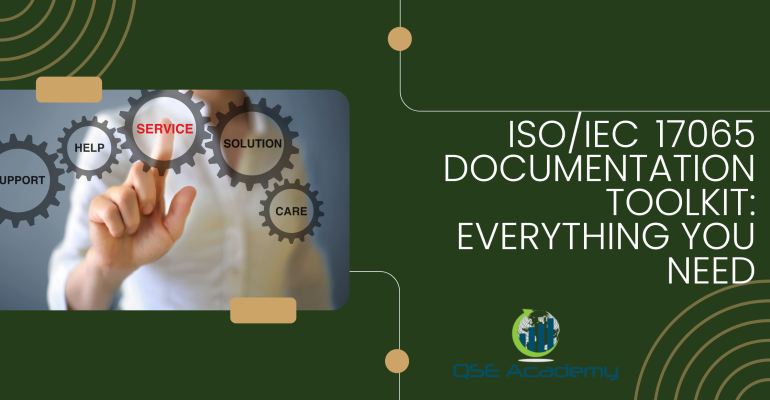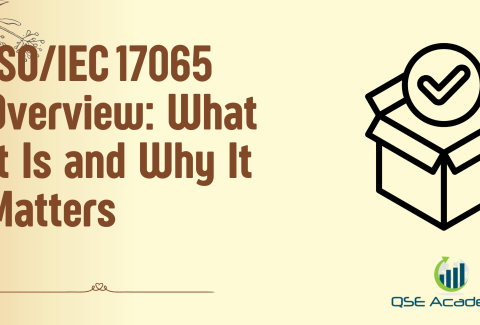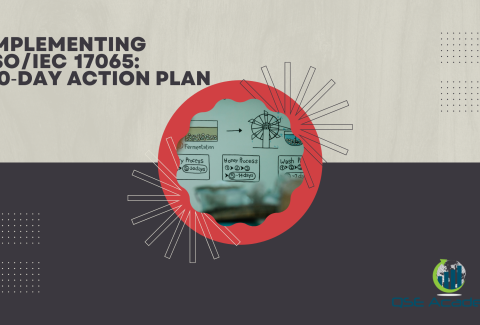ISO/IEC 17065 Documentation Toolkit: Everything You Need
Why a Complete ISO/IEC 17065 Documentation Toolkit Matters
When a Certification Body prepares for ISO/IEC 17065 accreditation, documentation becomes the structural backbone of the entire certification system. Over the years supporting Certification Bodies across technical sectors, I’ve noticed a recurring challenge: teams often understand the technical requirements but struggle to translate them into a controlled, consistent, audit-ready documentation framework. That gap—between knowing what must be done and documenting it correctly—is where most nonconformities arise.
This documentation toolkit provides a complete, structured breakdown of every document you need to operate a compliant, transparent, and credible certification system. You’ll find clarity on mandatory procedures, scheme documents, evaluation records, decision documentation, competence controls, electronic document-management rules, and surveillance documentation. Each component is explained in a way that strengthens traceability, impartiality, and accreditation readiness.
Document Categories Overview (ISO/IEC 17065 Documentation Structure Framework)
Your documentation should not exist as scattered files. ISO/IEC 17065 expects a structured, controlled document hierarchy. The cleanest structure organizes documents into core categories:
- System governance
- Impartiality & confidentiality
- Competence management
- Scheme documentation
- Evaluation & testing records
- Certification decision records
- Complaints & appeals handling
- Surveillance & ongoing conformity
- Document-control & data integrity
This structure helps manage responsibilities, version control, access rules, and evidence traceability.
Pro Tip:
Create a documentation matrix mapping each ISO/IEC 17065 requirement to a specific document. This immediately resolves gaps and strengthens audit readiness.
Common Mistake:
Focusing solely on procedures while neglecting evidence records, logs, and forms that support implementation.
 Mandatory Procedures Set (ISO/IEC 17065 Required Procedures List)
Mandatory Procedures Set (ISO/IEC 17065 Required Procedures List)
ISO/IEC 17065 lists several procedures that must be documented and controlled. These are not optional. They define how your Certification Body functions and how risks are managed.
Required procedures include:
- Impartiality Procedure: outlines impartiality safeguards, risk assessments, mitigation controls, and committee oversight.
- Confidentiality Procedure: defines data access, confidentiality rules, security measures, disclosure pathways, and breach handling.
- Competence Management Procedure: establishes competence criteria, qualification processes, monitoring, training, and reassessment.
- Evaluation & Testing Procedure: defines evaluation sequences, test method selection, sampling rules, subcontractor controls, and record requirements.
- Certification Decision Procedure: ensures decision independence, defines decision criteria, evidence requirements, and approval authority.
- Complaints & Appeals Procedure: establishes intake, investigation, decision-making roles, timelines, and impartial review pathway.
- Scheme Management Procedure: governs design, review, updates, approval, alignment with regulatory and technical requirements.
Pro Tip:
Each procedure should include roles, responsibilities, required records, review intervals, and links to relevant templates.
Common Mistake:
Procedures written too generically, not aligned with the actual certification model, leading to unclear implementation.
Certification Scheme Documentation (ISO/IEC 17065 Scheme Development Requirements)
Your certification scheme defines the rules of your program. This document must be precise, structured, and aligned with regulatory expectations. A well-constructed scheme contains:
- Product scope definition
- Conformity criteria
- Normative references
- Detailed evaluation steps
- Testing requirements & acceptance limits
- Surveillance frequency & methods
- Labeling & certification mark usage rules
- Suspension, withdrawal, and conditional approval rules
Pro Tip:
Use a modular template so scheme updates can be applied consistently without recreating the entire structure.
Common Mistake:
Not updating schemes when regulations change—this creates immediate accreditation risk.
Evaluation & Testing Documentation (ISO/IEC 17065 Product Evaluation Records)
ISO/IEC 17065 requires clear evidence that evaluation activities were conducted consistently and aligned with conformity criteria. Documentation must include:
- Evaluation plan
- Sampling records
- Sample identification and chain-of-custody documentation
- Laboratory test reports
- Inspection checklists
- Technical analysis data
- Evaluation summary report
Pro Tip:
Implement a master traceability ID to connect samples, test reports, evaluation summaries, and decision logs.
Common Mistake:
Inconsistencies between sampling IDs and test report IDs, weakening traceability.
Certification Decision Documentation (ISO/IEC 17065 Decision Records Requirements)
Certification decisions must be justified and documented clearly. The documentation must show evidence, impartiality, criteria comparison, and approval authority.
A complete decision record includes:
- Decision log
- Evidence-reference matrix
- Conformity checklist status
- Justification notes
- Conditions or limitations
- Signature of decision-maker
- Decision date
Pro Tip:
Use a standardized decision log format across all product categories to ensure consistency.
Common Mistake:
Decisions recorded without documented justification—this results in immediate accreditation findings.
Competence Management Documentation (ISO/IEC 17065 Competence Requirements)
Your team must have documented competence based on product categories, technical complexity, and certification tasks. Documentation includes:
- Competence criteria per role
- Job descriptions aligned with certification activity
- Qualification evidence
- Training records
- Competence matrix
- Reassessment and monitoring logs
Pro Tip:
Regularly update competence matrices after internal training, regulatory changes, or scheme updates.
Common Mistake:
Generic competence criteria that fail to reflect specific technical requirements.
Electronic Document-Control & Record Management (ISO/IEC 17065 Digital Documentation Requirements)
Electronic document-control is expected, not optional. Your system must ensure:
- Controlled versioning
- Centralized master-document list
- Controlled access by role
- Audit trails
- Record retention schedule
- Archived and active versions separation
- Secure backup procedures
- Controlled retrieval
Pro Tip:
Tag documents using metadata: scheme, revision, category, review interval.
Common Mistake:
Teams using uncontrolled shared folders without version tracking.
Surveillance Documentation Set (ISO/IEC 17065 Ongoing Conformity Records)
Surveillance ensures ongoing conformity. Documentation must include:
- Surveillance plan
- Sampling rules
- Product testing during surveillance
- Market-surveillance findings
- Follow-up report
- Surveillance decision log
Pro Tip:
Use risk-based surveillance frequency rather than applying the same cycle to all product types.
Common Mistake:
Surveillance activities performed but not documented—no record means no evidence.
Toolkit Assembly & File Structure Best Practices (ISO/IEC 17065 Document Integration)
A complete toolkit must be organized into logical folders. The cleanest approach is a structured architecture:
- Governance & Policies
- Mandatory Procedures
- Certification Schemes
- Evaluation Records
- Testing Records
- Decision Logs
- Competence Documentation
- Complaints & Appeals
- Surveillance Records
- Electronic Document-Control System
Pro Tip:
Use controlled naming conventions: DOC-17065-Procedure-001-Rev03.
Common Mistake:
Mixing drafts with approved versions in the same folder.
FAQs — ISO/IEC 17065 Documentation Toolkit
What documents are required for ISO/IEC 17065 accreditation?
Mandatory procedures, scheme documents, evaluation records, decision records, competence documentation, complaints/appeals records, surveillance records, and document-control rules.
Can documentation be digital?
Yes—ISO/IEC 17065 allows digital systems as long as you maintain traceability, version control, and controlled access.
Can templates be modified to fit multiple product categories?
Yes. Templates should be adapted per category to meet technical complexity and regulatory requirements.
Conclusion — Build a Robust, Accreditation-Ready ISO/IEC 17065 Documentation System
A fully structured documentation toolkit is the foundation of a compliant certification body. When procedures match operations, schemes reflect regulatory expectations, evidence records are traceable, and decision logs are complete, your organization becomes stronger, more transparent, and far more credible.
Years of working with Certification Bodies have shown one clear truth: documentation issues can derail an accreditation process quickly, but a well-built system prevents those risks and improves overall performance.
If you need a complete documentation toolkit with ready-to-use templates, I can help build it in a clear, controlled, structured format designed for real accreditation readiness.
Melissa Lavaro is a seasoned ISO consultant and an enthusiastic advocate for quality management standards. With a rich experience in conducting audits and providing consultancy services, Melissa specializes in helping organizations implement and adapt to ISO standards. Her passion for quality management is evident in her hands-on approach and deep understanding of the regulatory frameworks. Melissa’s expertise and energetic commitment make her a sought-after consultant, dedicated to elevating organizational compliance and performance through practical, insightful guidance.









